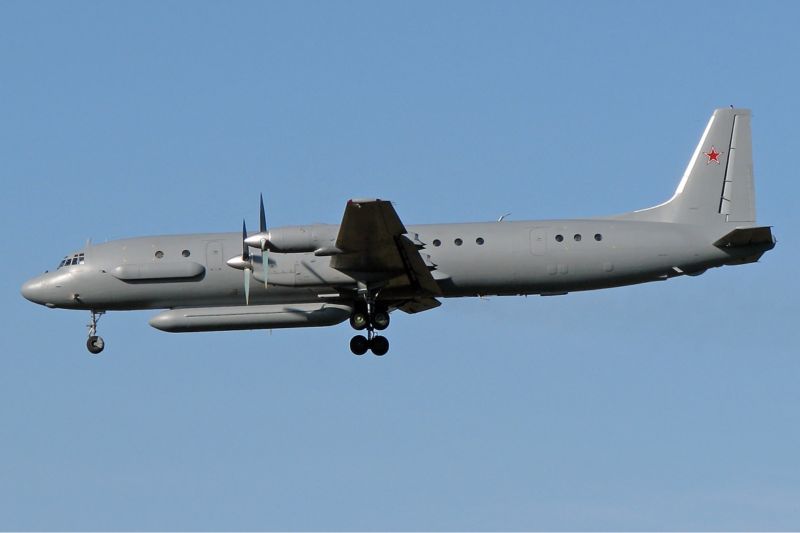
On Monday night, a Russian Air Force Ilyushin IL-20 "Coot-A" electronic intelligence and radar reconnaissance aircraft monitoring the Idlib province of Syria was mistakenly shot down by Syrian air defense forces after an Israeli air strike on facilities in Latakia, Syria. The Russian aircraft went down in the Mediterranean, about 27 kilometers (17 miles) off the Syrian coast near Latakia, with a loss of all 15 crewmembers aboard. Russian President Vladimir Putin said the downing was the result of a "chain of tragic accidental circumstances." But the Russian Defense Ministry has laid the blame for the downing on the Israelis, saying that they failed to provide enough warning to the Russians to give the IL-20 an opportunity to steer clear of danger.
"The Israeli pilots used the Russian plane as cover and set it up to be targeted by the Syrian air defense forces," a Russian Defense Ministry spokesperson said. "As a consequence, the Il-20, which has a radar cross-section much larger than the F-16, was shot down by an S-200 system missile." The Russians also claimed Israel only warned them a minute before the attack.
Russian Army General Sergei Shoigu told Israeli Defense Minister Avigdor Liberman in a phone call that the fault for the reconnaissance plane's downing "rests entirely with the Israeli side."
The IL-20 is a variant of Ilyushin's turboprop IL-18, an airliner first built in the late 1950s. It carries a large side-looking airborne radar (SLAR) in a torpedo-shaped pod under its fuselage, as well as a suite of signals collection antennae, infrared and optical sensors, and satellite communications gear. The aircraft is the Russian Air Force's leading intelligence-collection platform, and at least one has been deployed to provide overwatch in Syria since 2015. It allows Russia to listen in to anti-government and ISIS fighters' communications chatter and other electronic emissions, provide targeting data for Syrian military strikes, and keep an eye on the Turkish and US military units operating in and around Syria.
A spokesperson for the Israeli Defense Force acknowledged that Israeli aircraft struck a Syrian Armed Forces facility "from which systems to manufacture accurate and lethal weapons were about to be transferred on behalf of Iran to Hezbollah in Lebanon. These weapons were meant to attack Israel and posed an intolerable threat against it." But the strike was long over at the time the Russian aircraft was shot down, and the IL-20 was not within the area of the IDF strike at the time of the bombing.
There is likely truth to both the Russian and Israeli accounts of what happened—with the space in between filled in by the competence of Syria's Air Defense Force and the state of repair of Syria's S-200 missiles.
This old missile
-
An S-200 at Ghouta, near Damascus, in 2012 after the base was overrun.
-
Another S-200 in disrepair at Ghouta, near Damascus, in 2012 after the base was overrun.
-
An S-200 at Ghouta in a bunker, in 2012.
The S-200 (known to NATO as the SA-5 Gammon) was originally designed in the 1960s. While Syria had 48 S-200VE launchers in 2012, some of them were overrun during the early days of the Syrian Civil War, and others have been bombed by the Israelis. A new S-200 site was built near Aleppo in 2016, with three launchers, and the Russians have assisted Syria in bringing some of the other launch sites back online.
In May, during "Operation House of Cards," Israel bombed a number of S-200 sites again when they targeted Israeli aircraft striking Iranian Revolutionary Guard Corps units for launching a rocket barrage toward Israel.
In theory, the S-200VE systems operated by the Syrians—an export version developed in 1982—can track and engage up to five separate targets at a time. The missiles themselves—the V-880E/5V28E export version of the S-200—have a range of 240 kilometers (150 miles) and use a combination of solid rocket boosters and a liquid-fueled main engine.
The missiles themselves have semi-active homing—they carry no radar transmitter of their own but instead lock onto the reflected signal of the continuous-wave targeting radar without requiring command guidance from the launch site.
The Israeli Air Force has been fairly successful at jamming S-200 targeting radars in the past with its electronic warfare systems. Only one Israeli F-16 has been confirmed to have been downed by an S-200—on February 10, when returning from a strike in retaliation for an alleged Iranian UAV incursion into Israeli airspace. Both the pilot and the navigator managed to eject safely. In fact, the S-200s fired at Israeli aircraft have been a greater danger to people on the ground—one S-200 had to be intercepted by an Arrow missile after it lost its target and went ballistic, flying toward a populated area in Israel.
The Syrians are often late in getting their shots off. After the US, French, and British missile strikes on Syria in April, Marine Corps Lt. Gen. Kenneth F. McKenzie of the Joint Staff said that most of the Syrians' anti-aircraft missile launches "occurred after our strike was over" and followed ballistic trajectories—essentially firing wild into the sky. So it's likely that Syrian defenders were late to fire again Monday night—and designated the only target they could find in the direction they believed the attack came from.
This isn't the first time an S-200 has shot down an aircraft in error. In October 2001, the Ukrainian Air Force accidentally shot down a Siberian Airlines flight from Russia over the Black Sea, killing 78 Russian and Israeli citizens.
reader comments
297